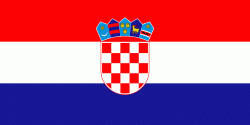Vir
Vir (Puntadura, Dalmatian: Punta de Ura) is an island on the Croatian coast of the Adriatic Sea with an area of 22 km2. It lies in Dalmatia, north of the city of Zadar. It is connected to the mainland via a road bridge. The main village on the island is the eponymous village of Vir. There are two more villages, Lozice and Torovi. According to the 2011 census, the island had a population of 3,000 inhabitants, making it the 13th most populous island in Croatia.
The highest peak on the island is Bandira (112 m).
The first known mention of Vir was in Mare Nostrum Dalmaticum (1069), a charter by Croatian king Peter Krešimir IV, where the island is referred to as Ueru (Veru), a word believed to have an ancient Mediterranean origin, meaning "pasture". As part of the Pacta conventa in 1102, defining the status of Croatia in personal union with Hungary, Vir and the area became a part of a union with the Kingdom of Hungary. During the 1241 Mongol invasion of Europe, the Hungarian King Béla IV of Hungary fled to the south, and the Mongol forces under the leadership of Kadan followed him all the way to Dalmatia, where they were repelled by the Croatian forces. Afterwards, Hungarian rule was quickly restored back to normal. In 1313, the Republic of Venice sent three thousand soldiers to the island, claiming it, and used it as a base to attack and conquer the nearby city of Zadar. This marks the new era of the reign of Venice over the area.
In the 16th century, the Ottoman conquest of Europe started to threaten the Dalmatian coast, causing Venice to build the Kaštelina fortress as a precaution in case of an Ottoman invasion. Local documents indicate that 36 people lived on Vir in 1579, and 130 people by 1603. During the Napoleonic Wars, Napoleon's army established the Illyrian Provinces over large swaths of Dalmatia, including Vir, as part of a direct rule of the First French Empire from 1809 to 1814. Following the defeat of the French forces, the area became part of the Austrian Empire, in 1867 reformed into Austria-Hungary. Following the dissolution of Austria-Hungary after World War I, Vir became part of the Kingdom of Yugoslavia, while the neighboring Zadar was left as an enclave of the Kingdom of Italy. In 1941, Fascist Italy ruled by Benito Mussolini conquered the rest of Dalmatia, while Vir was under the control of the Nazi puppet state of Independent State of Croatia. After World War II, Tito's Partisan forces expelled Italian forces and incorporated Zadar and Vir into the newly formed Socialist Federal Republic of Yugoslavia by 1945. Following the dissolution of Yugoslavia, Croatia declared independence from Yugoslavia, and the Croatian War of Independence escalated in 1991. The Serb and Yugoslav forces mounted an attack on the Zadar area, but were stopped. Vir became a part of the newly sovereign Croatia and was mostly untouched by the war, which ended in 1995.
The highest peak on the island is Bandira (112 m).
The first known mention of Vir was in Mare Nostrum Dalmaticum (1069), a charter by Croatian king Peter Krešimir IV, where the island is referred to as Ueru (Veru), a word believed to have an ancient Mediterranean origin, meaning "pasture". As part of the Pacta conventa in 1102, defining the status of Croatia in personal union with Hungary, Vir and the area became a part of a union with the Kingdom of Hungary. During the 1241 Mongol invasion of Europe, the Hungarian King Béla IV of Hungary fled to the south, and the Mongol forces under the leadership of Kadan followed him all the way to Dalmatia, where they were repelled by the Croatian forces. Afterwards, Hungarian rule was quickly restored back to normal. In 1313, the Republic of Venice sent three thousand soldiers to the island, claiming it, and used it as a base to attack and conquer the nearby city of Zadar. This marks the new era of the reign of Venice over the area.
In the 16th century, the Ottoman conquest of Europe started to threaten the Dalmatian coast, causing Venice to build the Kaštelina fortress as a precaution in case of an Ottoman invasion. Local documents indicate that 36 people lived on Vir in 1579, and 130 people by 1603. During the Napoleonic Wars, Napoleon's army established the Illyrian Provinces over large swaths of Dalmatia, including Vir, as part of a direct rule of the First French Empire from 1809 to 1814. Following the defeat of the French forces, the area became part of the Austrian Empire, in 1867 reformed into Austria-Hungary. Following the dissolution of Austria-Hungary after World War I, Vir became part of the Kingdom of Yugoslavia, while the neighboring Zadar was left as an enclave of the Kingdom of Italy. In 1941, Fascist Italy ruled by Benito Mussolini conquered the rest of Dalmatia, while Vir was under the control of the Nazi puppet state of Independent State of Croatia. After World War II, Tito's Partisan forces expelled Italian forces and incorporated Zadar and Vir into the newly formed Socialist Federal Republic of Yugoslavia by 1945. Following the dissolution of Yugoslavia, Croatia declared independence from Yugoslavia, and the Croatian War of Independence escalated in 1991. The Serb and Yugoslav forces mounted an attack on the Zadar area, but were stopped. Vir became a part of the newly sovereign Croatia and was mostly untouched by the war, which ended in 1995.
Map - Vir
Map
Country - Croatia
Currency / Language
| ISO | Currency | Symbol | Significant figures |
|---|---|---|---|
| HRK | Croatian kuna | kn | 2 |
| ISO | Language |
|---|---|
| HR | Croatian language |
| SR | Serbian language |

















